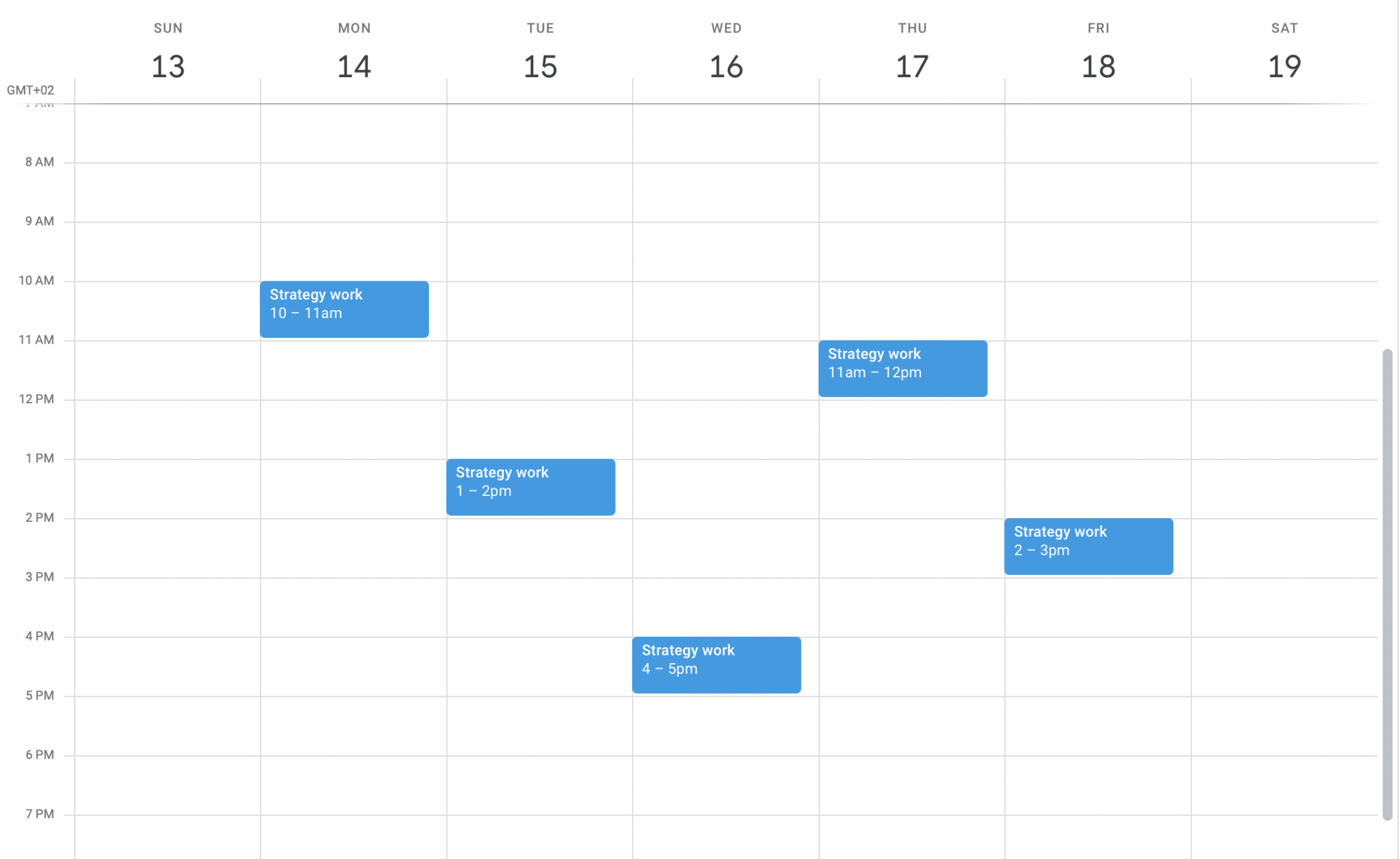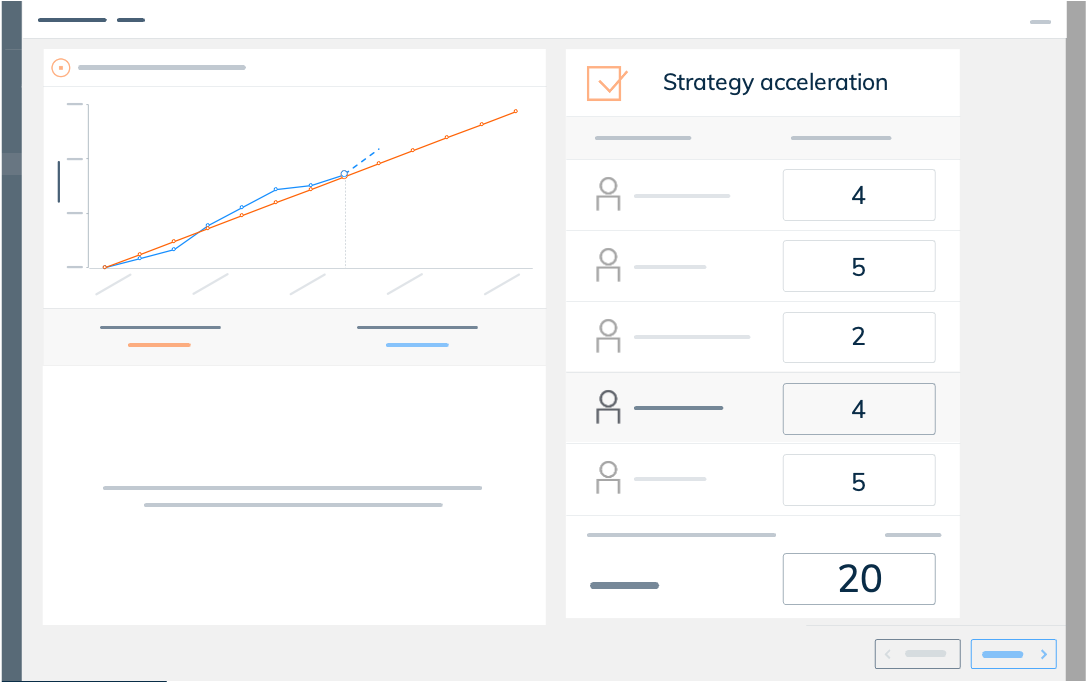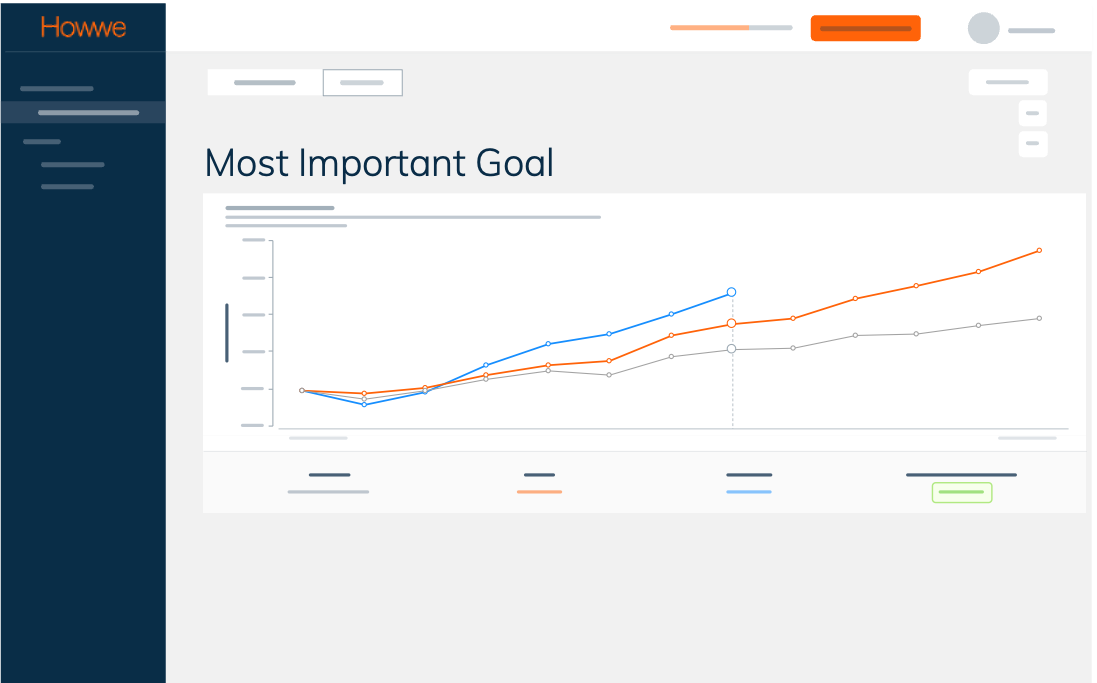How do you create conditions and ensure that the planned activities are executed according to plan? Read on to find out how to accelerate activities!
It is important to get started as quickly as possible with the activities that have been defined as most important to accelerate activities. Execution starts as soon as every level of the staircase has identified their activities. It is important to keep up the momentum. In strategy acceleration, this is accomplished by a structured process where everyone within the company works the same way. This last point is important in order to create unity and common ground— “This is how we work with the strategy.”
Step by step the most important activities are carried out until they are finished. New activities are defined, executed, and followed up. The work continues on all levels until the overall goal is reached. During execution, everyone within the organization reports on progress how they accelerate activities, and management can follow the progress both on an overall and detailed level.
What you need to accelerate activities
The most important things that create conditions to succeed in accelerate activities are:
- Freeing up time in the schedule for strategy activities
- Hold acceleration meetings every week
- Follow up on the acceleration of activities
- Know what to do when it does not go as planned to accelerate activities
- Support tools for strategy acceleration
- Determine how long you work on each MIG and on the activities
- Reward acceleration and not just results
We’ll go through each and every point in this list, but we’ll split it up into two posts. Follow us on LinkedIn to make sure you don’t miss out on upcoming posts and key insights about Strategy Acceleration and accelerate activities.
Freeing up time in the schedule
Time — or the lack thereof — is probably the biggest obstacle to succeeding with the strategy and accelerate activities. How can we free up time in a workday where the operative work completely dominates our schedule?
The answer is as follows:
1) Management has to make a definite decision that strategy acceleration will be implemented. Management also needs to stand behind the decision and encourage it. It must be absolutely clear that it is alright to spend time on the strategy execution. Everyone in the company (or everyone who is affected by the strategic work) does the same thing — allocates time in the schedule.
2) Open your calendar for the next year. You will probably see that it is completely full in the coming days or even weeks. Look three weeks ahead from today and schedule at least a one-time slot (one-time slot = 2 hours) per week during one year. Make the decision that these time slots are a high priority, nothing else can be scheduled at these times. Do not schedule more than the necessary time. Aim for what seems reasonable in order to keep the routine. In the beginning, it is important to feel that you have succeeded!
We know that freeing up time is a challenge in most companies. We meet a lot of stressed-out people who are struggling to keep their daily life together. Telling them that “You have to give the highest priority to the strategy execution” is a challenge. We have worked with many companies over the years and we can see a pattern — the companies that have been closest to financial ruin are also those who have the most difficulty with allocating time. It seems to be connected. This is an interesting thing to ponder. But we have seen many examples that show that it is possible to think on different tracks and the results come fast when everybody gets on the same track. It is important to keep in mind that this is about long-term survival. If the time is not invested today the company’s future will be at stake.
Questions for those who think they have absolutely no available time in their schedule — who think they cannot even free up two hours per week for accelerate activities:
- Get out your calendar. Do you not have two hours per week to set aside in order to prioritize strategy work and accelerate activities? Not even if you check some months ahead? Does it still look totally impossible? Is there an internal meeting that you could skip? Is there a task that you perform that you can deprioritize?
Are you a leader or a manager — help your employees to deprioritize tasks in favor of strategy execution. We know it is possible! And we know that it will pay off.

Weekly acceleration meetings
When everyone has allocated time in their schedules and the activities have begun, it is time for the next important element in strategy acceleration—the acceleration meetings. What is not followed up on does not happen, is a common saying. And it is true. The accelerate activities that have to be performed within the set time frame have to be constantly followed up. This is done in the exact same way throughout the company through structured acceleration meetings.
Progress follow-up is accomplished in a structured weekly 15-minute meeting.
Each leader schedules an acceleration meeting with the team members — a weekly fixed day and time. The leader has the great responsibility to create a good atmosphere at these gatherings. The meeting has to be motivating and the team should become more energized and committed. This is a meeting you want people to look forward to!
The meet-ups can be held with all team members in the same room, but it works equally well over the phone or video call. The only requirement is that both leaders and participants can see the common “dashboard” where the result of the accelerate activities is shown.

To make sure you make progress on your Key Activities to reach your Most Important Goals, a focused meeting a week is all you need. We call these Acceleration Meetings – they only take 15 minutes.
The meeting should roughly follow this outline:
The leader starts the meeting by discussing the goal and why we are doing this. This may not be necessary at every meeting but remember that it is good to follow up and repeat the why and the goals to be achieved.
The leader continues the meeting by positively acknowledging that everyone has spent time on strategy execution during the past week.
The leader asks each team member to report the results of the accelerate activities that were planned for the week.
Members of the team report their results. In our experience, basically all planned accelerate activities get done when you work like this since they are followed up. No one wants to come to the meeting and be the one that has not accomplished the planned activities.
Next, the leader asks each member what accelerate activities will be carried out in the coming week and how these will be distributed to the team. If someone is on sick leave or vacation the leaders try to motivate others in the team to take on the absent member’s tasks. If the team’s result was under last week’s target the leader tries to inspire the team to rise to the challenge and catch up.
Numbers are entered into a follow-up tool like Howwe and the week’s results are visualized on the screen or in some other way and the meeting is then declared closed. The leader is responsible for ending the meeting in a positive and motivating way. The goal is to have the team members leave the meeting with a positive feeling — “We have achieved something together!”
As a leader – DON’T do this
- Allow discussions on anything but strategy acceleration (avoid this kind of discussions in a kind but the firm way)
- Never express anything negative about or question a team member (feedback is only given individually when needed)
- Never arrive unprepared. If you do, you send a signal that this is not important and that you have not used your allocated time. Walk the talk.
- Do not come to the meeting without having accomplished planned accelerate activities.
How is the follow-up on strategy acceleration done?
This is what the outcome from a weekly meeting looks like when all team members have reported the number of finished accelerate activities and specified how many activities they will work on during the coming week. To create an efficient follow-up some sort of support tool is necessary. This is what it looks like in Howwe. On the dashboard, you report the team’s commitments, see current status in relation to starting point and the progress towards the goal.


What the lines on the dashboard tell you
The grey line in graph 2 shows the starting point before the strategy acceleration started—i.e. how many accelerate activities you were doing before you started. To be able to measure progress, to show that acceleration is happening, it is important to have the current status. Sometimes this current status is 0. No activities were carried out, sometimes a few were done. It can be difficult to describe the current status but you have to be a bit innovative. It is important. If you do not know your starting point you cannot measure progress. The grey line shows what the result would be if we continued doing things the way we have been.
The blue line shows the results for the accelerate activities the team has achieved.
The orange line shows the goal that the team and the leader have agreed upon.
The advantage of this type of measure is that the team can see from week to week how things have improved. The acceleration they have created becomes very clear. Since the “blue line” (result) lies close to the “orange line” the MIG will most likely be achieved because ”outcomes” are more than 100% better than ”historical” (before acceleration and focusing began).
If the “blue line” should be below the goal it is advantageous to have a “grey line” to compare to. You can see that at least you are doing better than before, which creates positive energy in the team and a strong will to continue and reach the goal the following week.
By freeing up time for the most important accelerate activities, as well as measuring weekly we see that 80-90% of all teams manage to accomplish the planned activities on time. We have never seen that a team fails to improve the activities by at least 30% compared to historical results (before the strategy acceleration started). It is very important to energize and create a positive attitude and never criticize people that are below their activity targets. If someone deliberately avoids contributing to the most important activities, the leader will give individual feedback. Never in front of the team.
The result from all teams are summarized on a “dashboard” (digital targeting) and the overall progress is displayed. It is a very powerful tool to keep the momentum and engagement going throughout the company. More about that in the next post.
What are you waiting for?
Howwe is the Solution for Growth.
With our method and software, we simplify the execution of your strategy.





